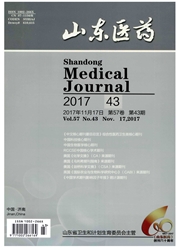

 中文摘要:
中文摘要:
目的探讨肾嫌色细胞癌和肾嗜酸细胞腺瘤的鉴别诊断要点。方法对14例肾嫌色细胞癌和2例肾嗜酸细胞腺瘤进行形态学观察、免疫组化染色与随访。结果肾嫌色细胞癌以实体结构为主,胞质半透明或嗜酸颗粒状,核皱缩,有核周空晕;其中4例(28.6%)为肾嫌色细胞癌伴肉瘤样变。嗜酸细胞腺瘤以巢状结构为主,胞质嗜酸颗粒状,核圆伴小核仁,部分细胞有核异型性。免疫组化示二者均表达CK;肾嫌色细胞癌无肉瘤变者与嗜酸性腺瘤均表达CD117,不表达CD10与vimentin;肾嫌色细胞癌CK7、p504s的阳性率分别为21.4%、28.6%,嗜酸性腺瘤二者均不表达。肾嫌色细胞癌无肉瘤样变者90%(9/10)为TNMⅠ~Ⅱ期,肾嫌色细胞癌肉瘤样变者均为TNMⅢ-Ⅳ期。结论肾嫌色细胞癌和嗜酸细胞腺瘤形态学各有特征,免疫表型相似,鉴别诊断基于生长方式和细胞学特征,伴肉瘤样变肾嫌色细胞癌预后差。
 英文摘要:
英文摘要:
Objective To investigate the essential points of differential diagnosis between chromophobe renal cell carcinoma (CRCC) and renal ancocytoma. Methods 14 cases of CRCC and 2 cases of renal oncocytoma were observed by using the morphological methods,immunohistochemical stains and follow-up if available. Results CRCC was comprised of solid structures with variable proportions of translucent and granular eosinophilic cells,wrinkled nuclei and preinuclear halos ;4 cases were classified as sarcomatoid variants of CRCC. Whereas oncocytoma was comprised of nests with granular eosinophilic cells ,round nuclei with inconspicuous nucleoli and cellular atypia. Immunohistochemical study showed that CK were positive in all the cases. The CD117 expression were positive in the cases of non-sareomatoid variants CRCC and oneocytoma,but CD10 and vimentin were negative. The expression rates of CK7 ,p504s in CRCC were 21.4% and 28.6% ,but were negative in oncocytoma. 90% (9/10) of non-sareomatoid variants CRCC were in TNM Ⅰ-Ⅱ stage,but all cases of sareomatoid variants CRCC(4/4) were in TNM Ⅲ-Ⅳ stage. Conclusions CRCC and renal oncocytoma have unique morphological features respectively, and share similarity in immunophenotype. Differential diagnosis is based on the growth patterns and cytological features. Cases with sareomatoid variants CRCC have poor prognosis.
 同期刊论文项目
同期刊论文项目
 同项目期刊论文
同项目期刊论文
 Alveolar soft part sarcoma: A bi-marker diagnostic strategy using TFE3 immunoassay and ASPL-TFE3 fus
Alveolar soft part sarcoma: A bi-marker diagnostic strategy using TFE3 immunoassay and ASPL-TFE3 fus 期刊信息
期刊信息
